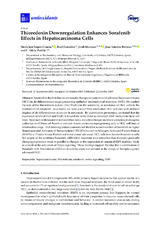Mostrar el registro sencillo del ítem
Thioredoxin Downregulation Enhances Sorafenib Effects in Hepatocarcinoma Cells
| dc.contributor.author | López-Grueso, María José | |
| dc.contributor.author | González, Raúl | |
| dc.contributor.author | Muntané Relat, Jordi | |
| dc.contributor.author | Bárcena Ruiz, José Antonio | |
| dc.contributor.author | Padilla, Alicia | |
| dc.date.accessioned | 2019-10-23T11:00:31Z | |
| dc.date.available | 2019-10-23T11:00:31Z | |
| dc.date.issued | 2019 | |
| dc.identifier.uri | http://hdl.handle.net/10396/19042 | |
| dc.description.abstract | Sorafenib is the first-line recommended therapy for patients with advanced hepatocarcinoma (HCC) in de-differentiation stage (presenting epithelial–mesenchymal transition, EMT). We studied the role of the thioredoxin system (Trx1/TrxR1) in the sensitivity or resistance of HCC cells to the treatment with Sorafenib. As a model, we used a set of three established HCC cell lines with different degrees of de-differentiation as occurs in metastasis. By quantitative proteomics, we found that the expression levels of Trx1 and TrxR1 followed the same trend as canonical EMT markers in these cell lines. Treatment with Sorafenib induced thiol redox reductive changes in critical elements of oncogenic pathways in all three cell lines but induced drastic proteome reprograming only in HCC cell lines of intermediate stage. Trx1 downregulation counteracted the thiol reductive effect of Sorafenib on Signal Transducer and Activator of Transcription 3 (STAT3) but not on Mitogen-Activated Protein Kinase (MAPK) or Protein Kinase B (Akt) and transformed advanced HCC cells into Sorafenib-sensitive cells. Ten targets of the combined Sorafenib–siRNATrx1 treatment were identified that showed a gradually changing expression trend in parallel to changes in the expression of canonical EMT markers, likely as a result of the activation of Hippo signaling. These findings support the idea that a combination of Sorafenib with thioredoxin inhibitors should be taken into account in the design of therapies against advanced HCC. | es_ES |
| dc.format.mimetype | application/pdf | es_ES |
| dc.language.iso | eng | es_ES |
| dc.publisher | MDPI | es_ES |
| dc.rights | https://creativecommons.org/licenses/by/4.0/ | es_ES |
| dc.source | Antioxidants 8(10), 501 (2019) | es_ES |
| dc.subject | Hepatocarcinoma | es_ES |
| dc.subject | Thioredoxin | es_ES |
| dc.subject | Sorafenib | es_ES |
| dc.subject | Redox signaling | es_ES |
| dc.subject | EMT | es_ES |
| dc.title | Thioredoxin Downregulation Enhances Sorafenib Effects in Hepatocarcinoma Cells | es_ES |
| dc.type | info:eu-repo/semantics/article | es_ES |
| dc.relation.publisherversion | http://dx.doi.org/10.3390/antiox8100501 | es_ES |
| dc.relation.projectID | Gobierno de España. BFU2016-80006-P | es_ES |
| dc.relation.projectID | Instituto de Salud Carlos III. PI13/00021 | es_ES |
| dc.relation.projectID | Instituto de Salud Carlos III. PI16/00090 | es_ES |
| dc.relation.projectID | Junta de Andalucía. BIO-0216 | es_ES |
| dc.relation.projectID | Junta de Andalucía. CTS-6264 | es_ES |
| dc.relation.projectID | Junta de Andalucía. PI-00025-2013 | es_ES |
| dc.relation.projectID | Junta de Andalucía. PI-0198-2016 | es_ES |
| dc.rights.accessRights | info:eu-repo/semantics/openAccess | es_ES |

